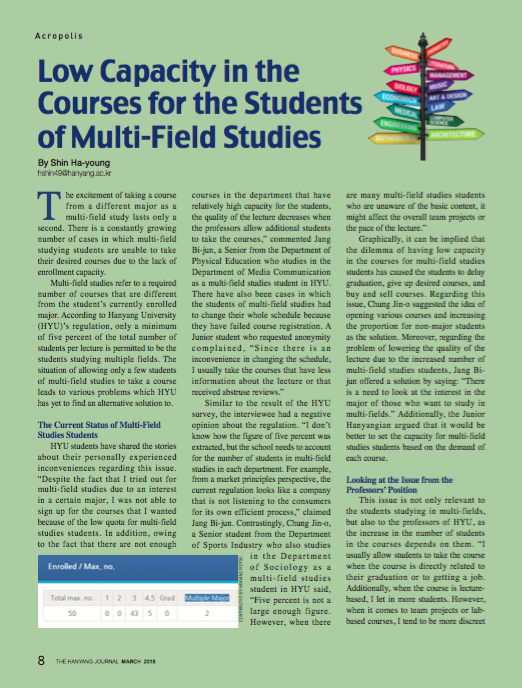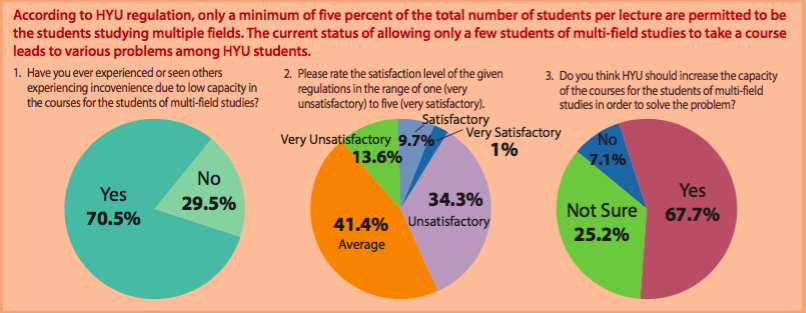
The excitement of taking a course from a different major as a multi-field study lasts only a second. There is a constantly growing number of cases in which multi-field studying students are unable to take their desired courses due to the lack of enrollment capacity.
Multi-field studies refer to a required number of courses that are different from the student’s currently enrolled major. According to Hanyang University (HYU)’s regulation, only a minimum of five percent of the total number of students per lecture is permitted to be the students studying multiple fields. The situation of allowing only a few students of multi-field studies to take a course leads to various problems which HYU has yet to find an alternative solution to.
The Current Status of Multi-Field Studies Students
HYU students have shared the stories about their personally experienced inconveniences regarding this issue. “Despite the fact that I tried out for multi-field studies due to an interest in a certain major, I was not able to sign up for the courses that I wanted because of the low quota for multi-field studies students. In addition, owing to the fact that there are not enough courses in the department that have relatively high capacity for the students, the quality of the lecture decreases when the professors allow additional students to take the courses,” commented Jang Bi-jun, a Senior from the Department of Physical Education who studies in the Department of Media Communication as a multi-field studies student in HYU. There have also been cases in which the students of multi-field studies had to change their whole schedule because they have failed course registration. A Junior student who requested anonymity complained, “Since there is an inconvenience in changing the schedule, I usually take the courses that have less information about the lecture or that received abstruse reviews.”

Similar to the result of the HYU survey, the interviewee had a negative opinion about the regulation. “I don’t know how the figure of five percent was extracted, but the school needs to account for the number of students in multi-field studies in each department. For example, from a market principles perspective, the current regulation looks like a company that is not listening to the consumers for its own efficient process,” claimed Jang Bi-jun. Contrastingly, Chung Jin-o, a Senior student from the Department of Sports Industry who also studiesin the Department of Sociology as a multi-field studies student in HYU said, “Five percent is not a large enough figure. However, when there are many multi-field studies students who are unaware of the basic content, it might affect the overall team projects or the pace of the lecture.”
Graphically, it can be implied that the dilemma of having low capacity in the courses for multi-field studies students has caused the students to delay graduation, give up desired courses, and buy and sell courses. Regarding this issue, Chung Jin-o suggested the idea of opening various courses and increasing the proportion for non-major students as the solution. Moreover, regarding the problem of lowering the quality of the lecture due to the increased number of multi-field studies students, Jang Bi- jun offered a solution by saying: “There is a need to look at the interest in the major of those who want to study in multi-fields.” Additionally, the Junior Hanyangian argued that it would be better to set the capacity for multi-field studies students based on the demand of each course.
Looking at the Issue from the Professors’ Position
This issue is not only relevant to the students studying in multi-fields, but also to the professors of HYU, as the increase in the number of students in the courses depends on them. “I usually allow students to take the course when the course is directly related to their graduation or to getting a job. Additionally, when the course is lecture- based, I let in more students. However, when it comes to team projects or lab- based courses, I tend to be more discreet about it as a large number of students might negatively affect the quality of the course,” explained Lee Young-mun, a professor of the Department of Media Communication in HYU. Similarly, Professor Park Kwang-joo, who teaches Newspaper Production in the Department of Media Communication in HYU added, “Students often visit my office or send e-mails to me with their own reason to take the course, so I usually accept most of the students at the optimum level.”
Furthermore, Professor Lee Yong- mun, who has been asked in many cases to increase the number of students, commented, “Practically speaking, setting the proportion as five percent is a necessary regulation since it is impossible to open spaces to all the students of multi-field studies.” He also suggested the idea that HYU should follow the guidelines, but also be flexible regarding the issue, so that students who are about to graduate or get a job can have the chance to take the classes.
HYU Elaborates on the Issue
HYU has clarified the current state of the problem among the number of openings for multi-field studies students. For the past few years, HYU has been working hard to establish policies to foster multi-field studies. “Providing five percent of the total number of students per lecture for multi-field studies students means that unlike other universities, we purely guarantee a certain capacity in a lecture for the multi-field studies students,” explained Jung Joon-ku, the Deputy Head of the Academic Services Team. He also added by saying, “At this moment, five percent is an ideal percentage as we have considered the major's students as the priority, and the fact that usually many students are able to register for the courses during the course add and drop period.”
HYU understands and admits that the professors have the authority to increase the number of spaces for the students in their courses. “HYU has no concrete rule yet about allowing more students than the original capacity of the course. Instead, we let the professors decide, as the professors are the ones who know about their classroom environment better than anyone else,” said Jung Joon-ku.
According to the Academic Services Team, in order to resolve the inconvenience, HYU deleted the policy of having to obtain an introductory major course as mandatory for students who study the Business Major as a multi-field study. Jung Joon-ku stated, “HYU is working hard in order to solve the problem. However, the system of course registration cannot be changed all at once. Since changing the system might have a huge effect on the students, HYU is being delicate with it, and it also requires more time to go through all the current situations including the possible side effects of any changes.”
The Proper Way to Proceed Regarding the Issue
The process of getting stressed about course registration amongst the students of multi-field studies and visiting professors to increase the number of seats has been an ongoing tug-of-war. Right now, all we can do is to wait for the system to change. Like the Academic Services Team mentioned before, it takes time to change the whole system, as it is a sensitive problem and cannot be changed easily. However, HYU still needs to continue to examine the seriousness of the problems regarding the issue. If it is difficult to increase the proportion of multi-field studies students, HYU should be able to come up with alternative solutions other than an augmentation of seats.

